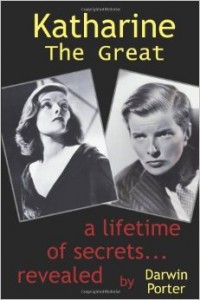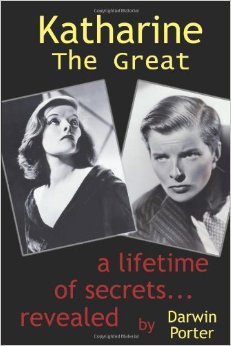 Katharine the Great: A lifetime of secrets … revealed
Katharine the Great: A lifetime of secrets … revealed
by Darwin Porter
Blood Moon Productions. 568 pages, $16.95 (paper)
THE BARE BONES of Katharine Hepburn’s life are well known: born in Connecticut into a well-connected family, brilliant career in the movies, had a long-term affair with Spencer Tracy, reclusive dotage before dying in 2003 at the age of 96. What we don’t know much about, except as rumor and speculation, are the details of her putatively lesbian lifestyle.
But along comes Darwin Porter with a tome of 568 pages that covers only the first 43 years of Hepburn’s life. The book, while fascinating reading, addictive really, is mostly based on unsubstantiated gossip. It barely touches on the filmmaking aspects of Hepburn’s life, focusing instead on her sex life and her many Hollywood and New York friends and lovers. The list of men and women that Hepburn supposedly bedded is enormous; and the list of men who were supposedly bisexual is almost as long.
After Hepburn met Laura Harding, an heiress to the American Express fortune, she had an on-again, off-again relationship with her until Harding died in 1994. They were lovers early on, and all indications are that they remained close after this aspect of their relationship ended. Kate, however, moved on: to Howard Hughes, Greta Garbo, Claudette Colbert, John Ford, Irene Selznick, among others. According to Porter, there was a time when she and Cary Grant shared Howard Hughes. Other bisexual stars include Gary Cooper, Randolph Scott, Humphrey Bogart, and Joan Crawford. Regarding Spencer Tracy, Porter says he was more interested in the bottle and in the boys down the lane—that in the end what Hepburn got from Tracy was an older brother, “not the cuddly father she always wanted.”
The book relays many episodes of bedroom antics in which Hepburn was not involved, with people like Grant, Hughes, Judy Garland, Vincente Minnelli, Robert Walker, Ginger Rogers, and Charles Boyer in various combinations. It abounds with references to cocksucking, tricking, and skillfulness in bed. There are many salacious comments, but the most outrageous are those about Nancy Davis before she was Mrs. Ronald Reagan. Porter reports that Loew’s vice president Benjamin Thau claimed that Nancy “became known around town for performing oral sex.” And later: “When Tracy stopped seeing Nancy, he told Cukor, ‘Miss Nancy is laying a trap for Ronnie boy. Who cares? Those two deserve each other. I just hope Ronnie baby goes in for oral sex like I do. If he does, he’ll be happy as a pig in shit.’”
A huge drawback is that there aren’t any footnotes in the book. When a comment is attributed to someone, it’s often couched as hearsay: “Irene (Selznick) jokingly told Cukor, ‘Before I met Kate I wasn’t a housebreaker. Believe me!’” Porter’s version of endnotes is a section with paragraphs of attribution that say things like: “In bits and pieces, staff members at Howard Hughes’ Muirfield mansion leaked information to the press.” He then lists housekeepers and other people linked to Hughes. One of the best ones is: “Marlene Dietrich herself provided information about her eastbound train ride with Hepburn after both stars had been labeled ‘box office poison.’” To whom did Dietrich tell this? How did Porter find out? Some stories Porter says were told directly to him; too bad there weren’t more of those. Porter doesn’t date most of the stories he tells and there isn’t a filmography to consult for context.
As enjoyable a read as this book is, one reads it with grain of salt. For instance, after Howard Hawkes showed Kate a snapshot of Cary Grant and Randolph Scott dancing in a club, he said, “These two fairies must really have balls to think they can get away with shit like that.” His remark infuriated Kate, who cautioned him: ”Don’t be homophobic.” This would have been in 1937, long before the word “homophobia” was coined.
Books about the gay lives of movie stars from the past comprise a small cottage industry in the U.S. What we learn from Katharine the Great is that in this age of celebrity everything we know about stars, would-be stars, and poseurs may still be based upon misinformation. The publicity machine, as pervasive and influential as it is, may still be spinning tales that we won’t be able to unravel until a generation after they’re gone. One can only hope that as more celebrities come out openly in their lifetime, they’ll be able to pre-empt the kind of free-form speculation to which someone like Hepburn is reduced.






